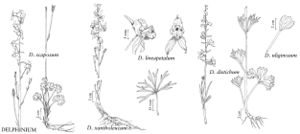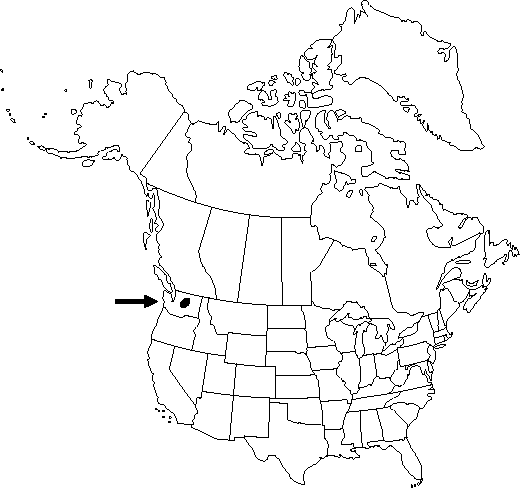Difference between revisions of "Delphinium xantholeucum"
Contr. U.S. Natl. Herb. 11: 280. 1906.
FNA>Volume Importer |
FNA>Volume Importer |
Revision as of 22:10, 16 December 2019
Stems 40-60(-100) cm; base often reddish, glabrous, ± glaucous. Leaves basal and cauline; basal leaves usually absent at anthesis; cauline leaves 4-6 at anthesis; petiole 0.8-16 cm. Leaf blade round, 2-6 × 4-10 cm, nearly glabrous; ultimate lobes 3-15, width 3-8 mm (basal), 1-5 mm (cauline). Inflorescences 10-20(-60)-flowered, narrowly pyramidal; pedicel spreading, yellowish, 1.5-3 cm, ± glandular-puberulent; bracteoles 6-12 mm from flowers, green to light brown, linear to lanceolate, 4-7 mm, nearly glabrous. Flowers: sepals yellow, glabrous, lateral sepals reflexed, 9-12 × 3-5 mm, spurs straight, ascending ca. 45° above horizontal, 11-15 mm; lower petal blades elevated, exposing stamens, 3-5 mm, clefts 1-2 mm; hairs centered mostly on inner lobes near base of cleft, white. Fruits 15-22 mm, 3-4 times longer than wide, glabrous to glandular-puberulent. Seeds: seed coat cells narrow, short, cell margins straight, surfaces smooth. 2n = 16.
Phenology: Flowering spring.
Habitat: Slopes in open yellow pine forests, grasslands, sage scrub
Elevation: 150-600 m
Discussion
Of conservation concern.
Delphinium xantholeucum is very local; much of the habitat of this species has been converted to orchards.
Selected References
None.

